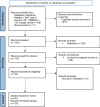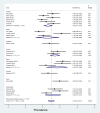Bacterial profile and antimicrobial resistance patterns of common bacteria among pregnant women with bacteriuria in Ethiopia: a systematic review and meta-analysis
- PMID: 35032208
- PMCID: PMC9411254
- DOI: 10.1007/s00404-021-06365-4
Bacterial profile and antimicrobial resistance patterns of common bacteria among pregnant women with bacteriuria in Ethiopia: a systematic review and meta-analysis
Abstract
Background: Globally, antimicrobial resistance (AMR) restricted the armamentarium of the health care providers against infectious diseases, mainly due to the emergence of multidrug resistant. This review is aimed at providing contemporary bacterial profile and antimicrobial resistance pattern among pregnant women with significant bacteriuria.
Methods: Electronic biomedical databases and indexing services such as PubMed/MEDLINE, Web of Science, EMBASE and Google Scholar were searched. Original records of research articles, available online from 2008 to 2021, addressing the prevalence of significant bacteriuria and AMR pattern among pregnant women and written in English were identified and screened. The relevant data were extracted from included studies using a format prepared in Microsoft Excel and exported to STATA 14.0 software for the outcome measure analyses and subgrouping.
Results: The data of 5894 urine samples from 20 included studies conducted in 8 regions of the country were pooled. The overall pooled estimate of bacteriuria was 15% (95% CI 13-17%, I2 = 77.94%, p < 0.001) with substantial heterogeneity. The pooled estimate of Escherichia coli recovered from isolates of 896 urine samples was 41% (95% CI 38-45%) followed by coagulase-negative Staphylococci, 22% (95% CI 18-26%), Staphylococcus aureus, 15% (95% CI 12-18%), Staphylococcus saprophytic, 12% (95% CI 6-18%) Proteus mirabilis, 7% (95% CI 4-10%), Enterococcus species, 6% (0-12%), Pseudomonas aeruginosa, 4% (2-6%), Citrobacter species, 4% (95% CI 2-4%), Group B streptococcus, 3% (1-5%), and Enterobacter species, 2% (1-4%). Multidrug resistance proportions of E. coli, Klebsiella species, Staphylococcus aureus and Coagulase negative staphylococci, 83% (95% CI 76-91%), 78% (95% CI 66-90%), 89% (95% CI 83-96%), and 78% (95% CI 67-88%), respectively.
Conclusion: The result of current review revealed the occurrence of substantial bacteriuria among pregnant women in Ethiopia. Resistance among common bacteria (E. coli, Klebsiella species, Staphylococci species) causing UTIs in pregnant women is widespread to commonly used antibiotics. The high rate of drug resistance in turn warrants the need for regular epidemiological surveillance of antibiotic resistance and implementation of an efficient infection control and stewardship program.
Keywords: Antimicrobial resistance; Ethiopia; Meta-analysis; Pregnant women; Significant bacteriuria; Urinary tract infection.
© 2022. The Author(s).
Conflict of interest statement
The authors declare that they have no competing interests.
Figures




















Similar articles
-
Epidemiology of staphylococci species and their antimicrobial-resistance among patients with wound infection in Ethiopia: a systematic review and meta-analysis.J Glob Antimicrob Resist. 2022 Jun;29:483-498. doi: 10.1016/j.jgar.2021.10.025. Epub 2021 Nov 18. J Glob Antimicrob Resist. 2022. PMID: 34801740
-
Bacterial profile and antimicrobial resistance patterns among pediatrics patients with suspected bloodstream infections in Ethiopia: a systematic review and meta-analysis.BMC Infect Dis. 2025 Aug 9;25(1):1008. doi: 10.1186/s12879-025-11427-y. BMC Infect Dis. 2025. PMID: 40783681 Free PMC article.
-
The prevalence of vancomycin-resistant Staphylococcus aureus in Ethiopia: a systematic review and meta-analysis.Antimicrob Resist Infect Control. 2023 Aug 30;12(1):86. doi: 10.1186/s13756-023-01291-3. Antimicrob Resist Infect Control. 2023. PMID: 37649060 Free PMC article.
-
Bacterial profile and antimicrobial susceptibility pattern of urinary tract infection among diabetic patients at Bule Hora University Teaching Hospital, Southern Ethiopia.Sci Rep. 2025 Jul 6;15(1):24112. doi: 10.1038/s41598-025-05782-8. Sci Rep. 2025. PMID: 40619446 Free PMC article.
-
Multidrug resistance from a one health perspective in Ethiopia: A systematic review and meta-analysis of literature (2015-2020).One Health. 2022 Apr 20;14:100390. doi: 10.1016/j.onehlt.2022.100390. eCollection 2022 Jun. One Health. 2022. PMID: 35686143 Free PMC article. Review.
Cited by
-
Bacteriuria profile and antimicrobial sensitivity among pregnant women attending antenatal care at Jazan and Sabyia general hospitals, Jazan Region, KSA: A cross-sectional study.Int J Gynaecol Obstet. 2025 Aug;170(2):751-759. doi: 10.1002/ijgo.70082. Epub 2025 Mar 24. Int J Gynaecol Obstet. 2025. PMID: 40125617 Free PMC article.
-
Using intersectionality to study gender and antimicrobial resistance in low- and middle-income countries.Health Policy Plan. 2023 Oct 11;38(9):1017-1032. doi: 10.1093/heapol/czad054. Health Policy Plan. 2023. PMID: 37599460 Free PMC article.
-
Impact of Genital Infections and Antibiotic Use on Incidence of Preterm Birth: A Retrospective Observational Study.Antibiotics (Basel). 2024 Mar 5;13(3):240. doi: 10.3390/antibiotics13030240. Antibiotics (Basel). 2024. PMID: 38534675 Free PMC article.
-
Global prevalence of macrolide-resistant Staphylococcus spp.: a comprehensive systematic review and meta-analysis.Front Microbiol. 2025 Mar 14;16:1524452. doi: 10.3389/fmicb.2025.1524452. eCollection 2025. Front Microbiol. 2025. PMID: 40182286 Free PMC article.
-
Dominance of antimicrobial resistance bacteria and risk factors of bacteriuria infection among pregnant women in East Africa: implications for public health.J Health Popul Nutr. 2025 Apr 2;44(1):98. doi: 10.1186/s41043-025-00767-9. J Health Popul Nutr. 2025. PMID: 40176149 Free PMC article.
References
Publication types
MeSH terms
Substances
LinkOut - more resources
Full Text Sources
Medical

